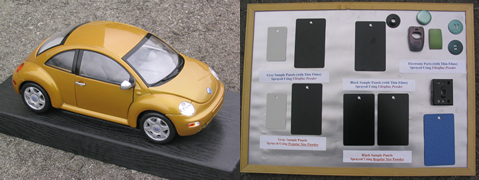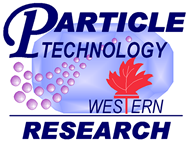
- Technological Overview
- Powder Coatings as an Alternative to Liquid Coatings
- Benefits of Using Ultra-Fine Powders Over Coarse Powders
- Challenges of Using Finer Powders
- Achievements of the New High Efficiency Ultra-Fine Powder Coating Technology
Powder paint coating is superior to liquid paint coating in that (1) it eliminates the use of petroleum-based solvents that are both expensive and harmful to the environment, and (2) it allows over spray paint powder to be recycled and reused. However, only coarse paint powders of 30-60 microns have been used for powder coating so far since powder of smaller sizes is extremely difficult to flow. The main problem with coarse paint powders is that they cannot form a smooth enough layer on the surface, so that the coating is not very uniform after curing. This prevents the environmentally-friendly powder coating technique from being used for high-quality surface finishing such as the exterior surface of automobiles.
The use of ultrafine powder (10-20 microns), if flow well, has been shown to overcome the above problem since it can apply a very uniform layer of paint powder on the surface. However, because of the very strong interparticle forces, finer powders become very sticky and do not flow well or not at all in the powder coating application equipment, resulting in poor surface finishing. To handle those ultrafine paint powders effectively, we have developed novel techniques (US Patent 6,833,185, plus more patents pending) that can effectively eliminate those interparticle forces. In the research and development work, we applied our novel ultrafine powder handling method in the powder coating process and very high-quality surface finishing has been achieved. This technology has also led to thin film coatings, that was not achievable with coarser powders given their larger diameter. Thinner coatings leads to significant savings when thicker films are not needed and also allow powder coatings to compete with liquid coating. The coating film using our ultrafine powder has also been shown to be more consolidated and durable than the regular powder coating. This technology has now been licensed and commercialized by a couple of licensees. Commercial production with ultrafine powder coating in a local company over a period of two years has shown superb finishing quality and 45% savings on powder usage. This research and development project is expected to lead significant changes to the whole ultrafine powder coating process. Limited world-wide license on this technology is still available for potential licenses.
2) Powder Coatings as an Alternative to Liquid Paint Coatings:
- Powder coatings are less harmful to the environment than liquid paints because powder coatings do not use petroleum based solvents and powder coatings allow for over-strayed paint to be recycled and reused.
- Powder coatings also provide cost savings because the over-spray material can be reused which wastes less material.
- Powder coating results in a stronger coating than liquid paint coatings.
- Current powder coating technology can not produce thin films (less than 50 micrometers).
- Current powder coating technology can not produce a smooth enough surface finish to be used in high-quality surface finishing such as the exterior surface of automobiles.
3) Benefits of Using Ultra-fine Powders Over Coarse Powders
- It is possible to achieve thinner films which uses less material resulting more cost savings.
- The smaller particle size results in a smoother surface finish allowing higher quality parts to be coated.
- Thinner films also eliminate the need for masking holes and other areas that require tight tolerances.
4) Challenges of Using Finer Powders:
- Ultra-fine powders (10-20 micrometers) are difficult to fluidize compared to coarse powders (30-60 micrometers). This results in difficulties in applying the ultra-fine powder to the parts.
- Ultra-fine powders need to be compatible with existing powder spray facilities without any major change in equipment.
5) Achievements of the New High Efficiency Ultra-Fine Powder Coatings Technology:
- The problems of fluidization have been overcome using our ultra-fine powder technology.
- Ultra-fine powder coatings have been commercialized by a powder coating company.
- A 50-70% reduction in surface roughness is noted when using ultra-fine powders compared to coarse powders.
- A low angle of repose (<40°), compared to >45° for untreated ultra-fine powder.
- A high bed expansion ratio (1.5 - 2.5), compared to <1.3 for untreated ultra-fine powders.
- The higher quality surface finish that this new technology achieves allows powder coatings to be used in applications where previously only a liquid paint could be used.
t
Also from this web page:

Contact Info
Particle Technology Research Centre (PTRC)
Faculty of Engineering
University of Western Ontario
London, ON, Canada, N6A 5B8
Tel: (519) 661-4243
Fax: (519) 661-3498
Email: powder@uwo.ca


